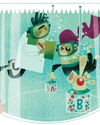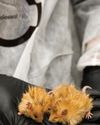يحاول ذهب - حر
Dreams Gone Bad
November/December 2016
|Muse Science Magazine for Kids
The Truth Behind Midnight Hauntings.

You wake, sensing an evil presence nearby. Terrified, you force your eyes open. A ghastly creature hovers above you. It pins you to the bed, leaving you gasping for air. You attempt to scream but can’t make a sound. You try to fight but can’t move a muscle.
Definitely scary. But obviously not something that could really happen, right? Wrong. People face attacks like these every night. You could be next.
Nightmares Come to Life
You probably call all scary dreams nightmares. But the word originally meant a supernatural attack. “Nightmare” comes from the Old Norse word mara, a spirit that suffocated people at night.
People around the world tell eerily similar stories of nighttime intruders. Ancient Greek texts describe demons that immobilized sleepers. Ugandan stories warn of the emisambwa, suffocating spirits of the dead. Colonial American testimony explains how witches paralyzed sleepers and stole their voices.
For centuries, people attempted to repel these evil spirits using everything from salt to knives to foul odors. They consumed holy water, recited prayers, and slept with religious objects. Despite these efforts, attacks continued. No one could stop them because no one knew what caused them.
Surprisingly, the first real clue came not from a paranormal expert, but from a bored graduate student.

Cracking Nighttime Mysteries
هذه القصة من طبعة November/December 2016 من Muse Science Magazine for Kids.
اشترك في Magzter GOLD للوصول إلى آلاف القصص المتميزة المنسقة، وأكثر من 9000 مجلة وصحيفة.
هل أنت مشترك بالفعل؟ تسجيل الدخول
المزيد من القصص من Muse Science Magazine for Kids

Muse Science Magazine for Kids
ANIMAL FIREFIGHTER TO THE RESCUE
Can animals help manage the risks of deadly wildfires?
3 mins
Muse July 2025: The Story Behind Wildfires

Muse Science Magazine for Kids
FIRE DANGER
WHY THE RISK OF WILDFIRES KEEPS GROWING
4 mins
Muse July 2025: The Story Behind Wildfires

Muse Science Magazine for Kids
The Miller NEW Normal
WHAT TODAY’S WILDFIRES TELL US ABOUT OUR FUTURE
8 mins
Muse July 2025: The Story Behind Wildfires

Muse Science Magazine for Kids
WOMEN AND FIREFIGHTING: A GOOD FIT
Jessica Gardetto is a firefighter. Her father was, too. “I grew up with my dad coming home smelling like wildfire and covered in soot,” she says.
1 min
Muse July 2025: The Story Behind Wildfires

Muse Science Magazine for Kids
What is happening on your fingertips when they get all wrinkly in a hot tub?
—Felix G., age 10, Montana
1 mins
Muse July 2025: The Story Behind Wildfires

Muse Science Magazine for Kids
WHEN the SMOKE CLEARS
THE LINGERING EFFECTS OF THE RECENT PACIFIC PALISADES AND ALTADENA EATON FIRES
6 mins
Muse July 2025: The Story Behind Wildfires

Muse Science Magazine for Kids
PICKING TEAMS
Keep it fair with a strategy that relies on geometry.
2 mins
Muse July 2025: The Story Behind Wildfires

Muse Science Magazine for Kids
SHAN CAMMACK
WILDLIFE BIOLOGIST AND FIRE SAFETY OFFICER
3 mins
Muse July 2025: The Story Behind Wildfires

Muse Science Magazine for Kids
Scientists Create Mice With Woolly Mammoth-Like Fur
RESEARCHERS AT A COMPANY IN TEXAS ARE WORKING TO CREATE A LIVING ANIMAL THAT RESEMBLES THE EXTINCT WOOLLY MAMMOTH. Recently, they produced mice with traits of the large mammal. The mice all have coats with mammoth-like fur, and some of the small mammals also have genes that help them store fat. Both features would help the animals survive in the cold Arctic, where the woolly mammoth once lived.
1 min
Muse July 2025: The Story Behind Wildfires

Muse Science Magazine for Kids
Cool Sunshade Added to the Nancy Roman Space Telescope
THE NANCY ROMAN SPACE TELESCOPE IS A NEW TELESCOPE THAT NASA IS BUILDING AND WILL LAUNCH INTO SPACE, LIKELY IN EARLY 2027.
1 min
Muse July 2025: The Story Behind Wildfires
Translate
Change font size
